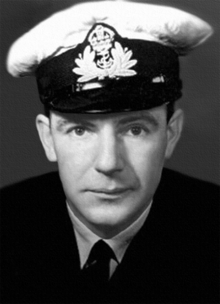Cecil Williams
Cecil George Williams (* 1909 in Cornwall , † 1979 in Great Britain ) was a British- South African theater director, anti-apartheid activist and member of the Umkhonto we Sizwe , the military wing of the African National Congress (ANC).
Life
Williams emigrated to South Africa in 1929. He has taught English at several renowned Johannesburg schools. During the Second World War , he volunteered as a soldier and served in the South African Royal Navy . Together with other South African war veterans, he founded the Springbok Legion in 1941 , which in the early 1950s became closer to the Communist Party of South Africa . He was also known to his students as a dedicated anti-fascist and a staunch opponent of apartheid. In 1952 he became the chairman of the Springbok Legion. The following year he joined the newly formed Congress of Democratsfor the white supporters of the ANC and, known for its combative attitude, later also the military wing Umkhonto We Sizwe, founded in 1961 .
In the 1940s at the latest, he turned to the theater. He played with the English actress Gwen Ffrangcon Davies and her friend Marda Vanne , who were visiting South Africa for a guest performance. A lifelong friendship developed from this encounter, and his correspondence with them shaped his understanding of the theater. His most important work includes The Kimberley Train of Lewis Sowden , which he produced in 1958 at the Library Theater. The play is about a love between a black woman and a white man who is separated by apartheid. Because of the racial segregation, the role of the woman was played by a white actress with dark make-up. Despite the subject matter, the play was a great success, especially among the white theatergoers, and achieved over 100 performances. Williams has also directed many classic theater plays and has worked with almost all known South African actors. He was also a well-known figure in Johannesburg's social life . He could only live his homosexuality hidden because of the threat of repression.
Rides with Nelson Mandela
Nelson Mandela wanted to return to South Africa in July 1962 after seeking support from abroad. However, he was wanted with an arrest warrant. Cecil Williams owned a new car that the police did not know and picked up Mandela from neighboring Bechuanaland , now Botswana . On the way back, Mandela disguised herself as a Williams chauffeur, a method they had successfully used before. At the end of July they safely reached the Liliesleaf Farm in Rivonia near Johannesburg, which the ANC used as a hiding place. Subsequently, Mandela wanted to travel to Durban , Natal , to meet with Albert John Luthuli . Despite the concerns of fellow campaigners of the ANC, it was decided that Mandela again posed as a chauffeur. The outward journey went without any problems, but Williams and Mandela neglected safety and took turns driving. On the way back from Durban on August 5, 1962, the car was stopped and both of them were arrested.
While Mandela was not released until 1990, Williams was able to leave prison the next day, but was under house arrest. His name appeared on a list of "Disapproved Persons" of the South African government, which meant that he was forbidden from attending meetings, and newspapers were no longer allowed to report on him or to quote him under threat of imprisonment. He was still allowed to play in other people's plays as long as his role was fixed and not improvised, but no one was allowed to play in his plays. Williams eventually fled back to his home country with his Scottish partner.
memory
Cecil Williams was forgotten after his escape and death in Great Britain. It was not until 1990 that the judge and civil rights activist Albie Sachs reminded of his role in a speech during a demonstration. The director Greta Schiller and the author Mark Gevisser shot the documentary The Man Who Drove with Mandela about his life and won the Teddy Award at the 1999 Berlinale . The film argues that the ANC's liberal stance and legislation on homosexuality stems from the friendship between Mandela and other ANC leaders of his generation with Cecil Williams.
literature
- Robert Aldrich, Garry Wotherspoon: Who's Who in Contemporary Gay and Lesbian History: From World War II to the Present Day. Routledge, London 2001, p. 446.
Web links
- Portrait at sahistory.org.za (English)
Individual evidence
- ^ A history of the Springbok Legion. sahistory.org.za, accessed August 5, 2017
- ^ Colin Martin Tatz: With intent to destroy: reflecting on genocide. Verso, 2003. pp. 5f.
- ^ Neil Roos: Ordinary Springboks: White Servicemen and Social Justice in South Africa, 1939-1961. Aldershot and Burlington: Ashgate, 2005.
- ^ Martial Rose: Forever Juliet: the life and letters of Gwen Ffrangcon-Davies, 1891-1992 . Larks Press, 2003.
- ↑ Ahmed M. Kathrada : Memoirs. Zebra Press, 2004. p. 150.
- ↑ A leader is a shepherd . In: Der Spiegel . No. 48 , 1994 ( online - excerpt from Nelson Mandela's memoir).
- ^ South Africa: Disapproved Persons . In: Time , August 10, 1962
- ↑ Shaun De Waal, Edwin Cameron , Anthony Manion: Pride: protest and celebration . 2006. p. 14.
| personal data | |
|---|---|
| SURNAME | Williams, Cecil |
| ALTERNATIVE NAMES | Williams, Cecil George (full name) |
| BRIEF DESCRIPTION | British-South African journalist, teacher, theater director, anti-apartheid activist |
| DATE OF BIRTH | 1909 |
| PLACE OF BIRTH | Cornwall |
| DATE OF DEATH | 1979 |
| Place of death | Great Britain |
